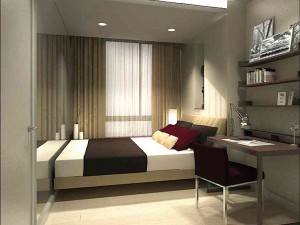
IN THE mid- to lower-end condominiums, it is not unusual to find bedrooms where the room dimensions are just enough for a bed to fit.
How do you define the size of your spaces? I prefer mine to be physically adequate, and yet large in possibility. Small enclosed spaces don’t bother me, but places cramped with people do. I’d rather be alone in a small space than with a lot of people in a large one. I don’t like hawker’s markets, and I hate going to crowded bazaars. On these occasions, I experience mild panic attacks. It is not claustrophobia, it’s just a fear of having my “personal space” intruded upon.
With proxemics, or the study of physical space and the human being’s cultural, behavioral and psychological behavior response to it, people are trying to find ways to protect their personal bubbles and create private spaces. But how much does each person really need? The question rang in, too, the other night, as I watched inmates mingle in near sub-human conditions, squeezed into jail cells in the movie “On the Job.” Was it justified that they lived in a hell-on-earth environment with only a few inches between their warm bodies as they went about the day? Maybe to them, the personal proximity didn’t matter. Space is relative.
Personal space
The way a densely populated environment is managed can shift the perception of both physical and personal space. Singapore has roughly 10,000 persons per square kilometer of land, and our very own Metro Manila has an estimated 19,000 persons per square kilometer. The big difference between the former and our own is that we have taken over the land and sprawled horizontally, while they have gone vertical with carefully planned high-rise buildings. They’ve created more floor space and supported that with efficient transport systems, preserving precious open spaces like parks, water bodies and protected forest areas. We, on the other hand, have packed everyone in at ground level with very little elbow room to move. Slowly we’re having to go vertical, but under undesirable conditions and reactive city planning.
The cost of land in the city has made the sizes of dwelling units nearly claustrophobic. As an example, low-end condominiums have rooms shrunken to the minimum 12 square meters for a bedroom, and there are studio units at 18 sq m. One-bedroom units are built within 24 sq m. Despite their size, these spaces can be efficiently utilized and made functional and habitable.
But usefulness of space is not its only qualifier for habitation. In the areas within the city where people live in abject poverty, they squeeze themselves into slivers. I have a friend, now a Jesuit priest, who told me about an immersion exercise in the plighted Baseco compound in Navotas. He had to live and sleep with a family of seven in 9 sq m of space, the same space they use for cooking, dining and lounging when they were not sleeping. Space made useful, but not necessarily habitable. At least not by eight. In Hong Kong, there have been recent protests against the shrinking size of public housing, where some are now at par with our 9-sq-m Baseco abode. People who live in these conditions develop much smaller personal bubbles, but to constantly stand within inches of another warm body is probably universally undesirable.
Personal bubble
The more fortunate among us live in homes that spread for a few hundred square meters, with bathrooms much bigger than the Baseco home. And that’s fine when you’ve earned it. Born into larger spaces and less dense environments, most of the upper class and upper-middle class population will have developed smaller personal bubbles. Sometimes, despite being able to afford properties within the city, the less crowded suburbs prove to be an attraction to their need for space. Then you have people like Janet Lim-Napoles who have lived in many huge spaces and have grown accustomed to it and more, but have to shift to what they look upon as a microcosmic living space: a bungalow for one, with roughly 50 sq m of expanse. Rat hole to her but mansion to the Baseco folks. But that should be fine for her, too. She earned it.
Like many others who shift between good and bad times, and the times that fall in between, you can always redefine your spaces.
Contact the author through designdimensions@abi.ph or through our Asuncion Berenguer Facebook account.

